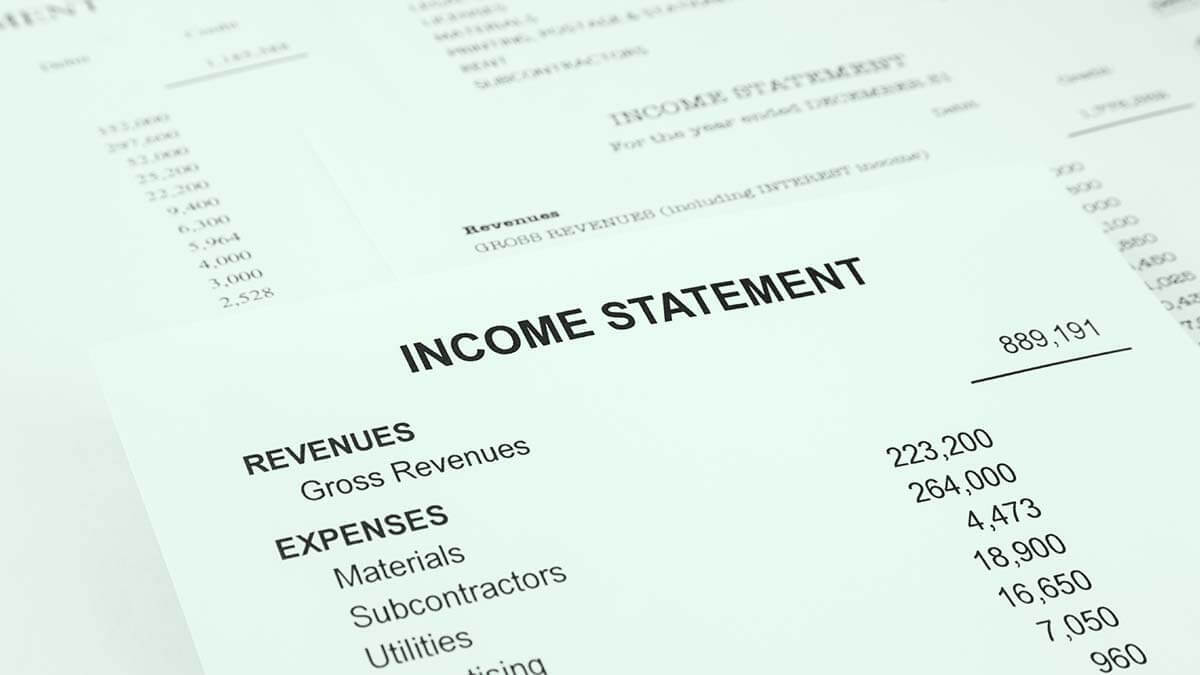Trend Analysis helps to analyze the percentage change in the financial performance of a company over two or more years, compared to the base year. In the article, we will learn about trend analysis of income statement with two examples.
Firstly, trend analysis requires two or more years of data. Secondly, the earliest years are the base years which are always 100%. Lastly, the representation is always in percentage.
In Trend Analysis of Income Statements, one does not compare the financial performance of two years. One just evaluates the growth of each component of the income statement over a given period, which is two or more years with the base year.
Further, the formula for Trend Analysis= Each Year Amount/Base Year Amount*100.
Vertical Income Statement (General Format)
The Vertical Income Statement starts with Gross Sales. If there are any sales returns, deduct them from sales to arrive at Net Sales.
Further, to calculate COGS (Cost of Goods Sold) = Trading Account Debit Side items + Factory Expenses- Trading Account Credit Side items.
Then, Net Sales – COGS gives Gross Profit or Loss. Moreover, by deducting Operating Expenses (admin, sales, and finance) and adding Operating Incomes to Gross Profit, one arrives at Operating Profit or Loss. Operating Profit/Loss= Gross Profit/Loss – Operating Expenses + Operating Incomes.
Further, on deducting Non-Operating Expenses and adding Non-Operating Incomes to Operating Profit or Loss, one arrives at Net Profit Before Tax (NPBT). NPBT= Operating Profit/Loss – Non- operating Expenses + Non-operating Incomes.
Then, deduct tax provisions from NPBT to arrive at Net Profit After Tax (NPAT). NPAT= NPBT- tax provisions. Moreover, any profit or balance of last year gets added or deducted to NPAT, known as adjusted NPAT.
Lastly, deduct appropriations from NPAT to arrive at Retained Earnings.
Retained Earnings= NPAT/Adjusted NPAT – Appropriations.

Example 1: Trend Analysis of Income Statement
| Particulars | 2021 | 2020 | 2019 | 2018 |
| Sales | 9,20,000 | 6,50,000 | 4,40,000 | 6,00,000 |
| Cost of sales | 3,50,000 | 3,15,000 | 2,55,500 | ,75,000 |
| Office expenses | 67,500 | 77,500 | 75,000 | 95,000 |
| Selling expense | 1,02,000 | 91,000 | 64,000 | 60,000 |
| Finance expense | 20,000 | 20,000 | 20,000 | 20,000 |
| Tax provision | 79,500 | 51,325 | 63,050 | 51,000 |
|
PARTICULARS |
YEARS |
TREND PERCENTAGES |
||||||
|
2018 |
2019 | 2020 | 2021 | 2018 | 2019 | 2020 |
2021 |
|
| Net Sales | 6,00,000 | 4,40,000 | 6,50,000 | 9,20,000 | 100.00% | 73.33% | 108.33% | 153.33% |
| (-) Cost of Sales | 2,75,000 | 2,55,500 | 3,15,000 | 3,50,000 | 100.00% | 92.91% | 114.55% | 127.27% |
| GROSS
PROFIT |
3,25,000 | 1,84,500 | 3,35,000 | 5,70,000 | 100.00% | 56.77% | 103.08% | 175.38% |
| (-) Operating
Expenses: |
||||||||
| Administrative
Expenses |
95,000 | 75,000 | 77,500 | 67,500 | 100.00% | 78.95% | 81.58% | 71.05% |
| Selling
Expenses |
60,000 | 64,000 | 91,000 | 1,02,000 | 100.00% | 106.67% | 151.67% | 170.00% |
| Finance
Expenses |
20,000 | 20,000 | 20,000 | 20,000 | 100.00% | 100.00% | 100.00% | 100.00% |
| 1,75,000 | 1,59,000 | 1,88,500 | 1,89,500 | 100.00% | 90.86% | 107.71% | 108.29% | |
| OPERATING PROFIT | 1,50,000 | 25,500 | 1,46,500 | 3,80,500 | 100.00% | 17.00% | 97.67% | 253.67% |
| (-) Provision for Tax | 51,000 | 63,050 | 51,325 | 79,500 | 100.00% | 123.63% | 100.64% | 155.88% |
| NET PROFIT AFTER TAX | 99,000 | -37,550 | 95,175 | 3,01,000 | 100.00% | -37.93% | 96.14% | 304.04% |
- Firstly, the earliest year is 2018. Hence, it is the base year. Every component of 2018 has a trend percentage of 100.
- For example, if one wants to know the gross profit for 2020. The gross profit for 2018 (base year) is ₹3,25,000 and ₹3,35,000. Then, the trend growth= 3,35,000/3,25,000*100. Hence, the trend percentage is 103.38%.
- For trend analysis of the income statement, the same formula and method are applicable for all the components of the income statement.
- Another example is to check the trend growth of NPAT for 2019. The Net Profit for the base year is ₹ 99,000 and the operating loss is ₹ 37,550. Since there is a loss, the trend growth also reverses and become negative. The formula remains the same= -99,000/37,550*100. Hence, the trend percentage is -37.93%.

Example 1: Conclusion
For the above trend analysis of the income statement, we can conclude that:
- Firstly, Net Sales show a mixed trend. In 2019, it falls marginally but it increases in 2020 and 2021, compared to the base year.
- Secondly, the Cost of Sales also shows a mixed trend like net sales.
- Similarly, Gross Profit also shows a mixed trend as it depends on sales.
- Moreover, Net Profit After Tax becomes negative in 2019 due to less operating profits and more tax provision. But it increases drastically in 2021.
- Lastly, operating profits also has a mixed pattern, if decreased drastically in 2019 but again increases tremendously in 2021.
Example 2: Trend Analysis of Income Statement
| Particulars | 2011 | 2012 | 2013 | 2014 |
| Sales | 50,000 | 62,000 | 70,000 | 86,500 |
| Cost of Sales | 32,000 | 35,000 | 47,000 | 56,000 |
| Administrative Expenses | 35,000 | 35,000 | 40,000 | 50,000 |
| Sales Expenses | 50,000 | 60,000 | 72,500 | 90,000 |
| Finance Expenses | 20,000 | 30,000 | 60,000 | 70,000 |
| Income tax | 8,000 | 10,000 | 15,000 | 20,000 |
| PARTICULARS | YEARS | TREND PERCENTAGES | ||||||
| 2011 | 2012 | 2013 | 2014 | 2011 | 2012 | 2013 | 2014 | |
| Net Sales | 50,000 | 62,000 | 70,000 | 86,500 | 100.00% | 124.00% | 140.00% | 173.00% |
| (-) Cost of Sales | 32,000 | 35,000 | 47,000 | 56,000 | 100.00% | 109.38% | 146.88% | 175.00% |
| GROSS PROFIT/ (GROSS LOSS) | 18,000 | 27,000 | 23,000 | 30,500 | 100.00% | 150.00% | 127.78% | 169.44% |
| (-) Operating Expenses: | ||||||||
| Administrative Expenses | 35,000 | 35,000 | 40,000 | 50,000 | 100.00% | 100.00% | 114.29% | 142.86% |
| Selling & Distribution Expenses | 50,000 | 60,000 | 72,500 | 90,000 | 100.00% | 120.00% | 145.00% | 180.00% |
| Finance Expenses | 20,000 | 30,000 | 60,000 | 70,000 | 100.00% | 150.00% | 300.00% | 350.00% |
| 1,05,000 | 1,25,000 | 1,72,500 | 2,10,000 | 100.00% | 119.05% | 164.29% | 200.00% | |
| OPERATING LOSS | -87,000 | -98,000 | -1,49,500 | -1,79,500 | 100.00% | 112.64% | 171.84% | 206.32% |
| (-) Provision for Tax | 8,000 | 10,000 | 15,000 | 20,000 | 100.00% | 125.00% | 187.50% | 250.00% |
| NET LOSS AFTER TAX | -95,000 | -1,08,000 | -1,64,500 | -1,99,500 | 100.00% | 113.68% | 173.16% | 210.00% |
- Firstly, the earliest year is 2011. Hence, it is the base year. Every component of 2011 has a trend percentage of 100.
- Secondly, in the above example, there is operating a net loss for all the years. In such a case, the base year is also negative. Hence, we ignore the negative sign when there is a loss in the base year as well as in all the following years. It depicts that the net loss is widening year after year.
- Therefore, a trend percentage less than 100 indicates a decrease when compared to the base year. Similarly, a trend percentage of more than 100 indicates an increase when compared to the base year.
- Lastly, negative trend percentages depict negative numbers/losses.
Example 2: Conclusion
- Firstly, Net Sales is showing an increasing trend.
- Secondly, the Cost of Sales also shows an increasing trend.
- Similarly, Gross Profit also shows an increasing trend as it is dependent on net sales.
- Moreover, Operating and Net Loss, due to a large number of operating expenses, are showing an increasing trend.




